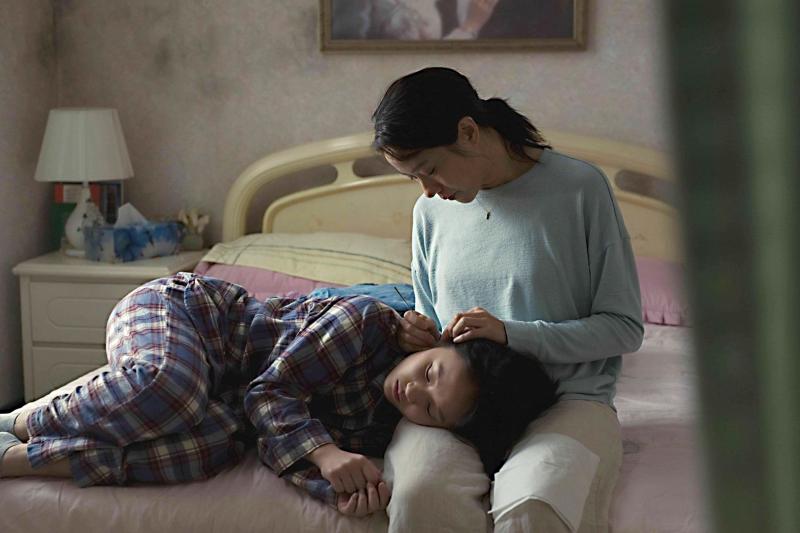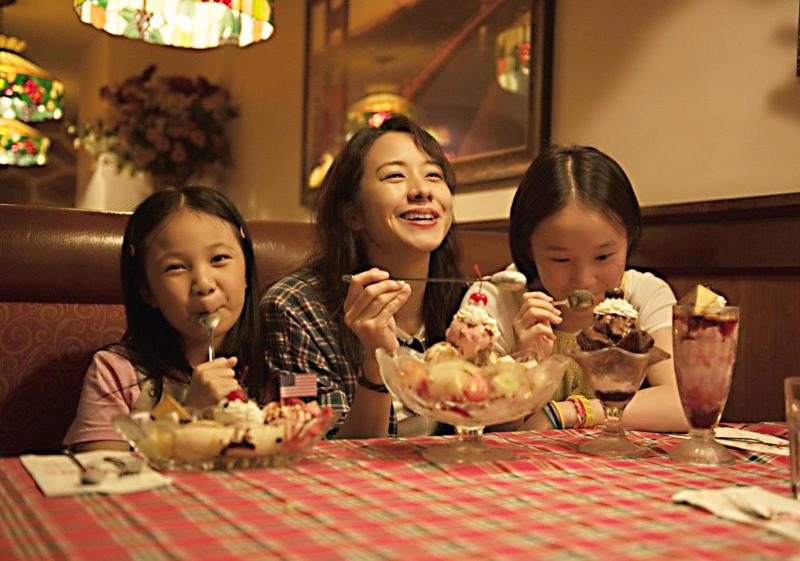American Girl (美國女孩) is a slice-of-life drama that captures a short but turbulent period in the life of 13-year-old Fen (Caitlin Fang, 方郁婷), who is suddenly transplanted from Los Angeles to Taipei, where her father works, due to her mother’s cancer treatment.
The much hyped film was made available last week on Netflix after a strong Golden Horse showing last year: Fiona Roan Feng-i (阮鳳儀) won best new director, Fang claimed best new actor while the film won best cinematography and the Audience Choice Award.
The challenges of adapting to a new culture and its school system will resonate strongly with diaspora kids caught between both worlds. The details — from being hit by a teacher over bad test scores, to being called “American” by classmates and wolfing down banana floats at Swensen’s for a taste of home — are trips down memory lane.

Photo courtesy of iFilm
Meanwhile, the 2003 SARS epidemic looms, and the film puts great care into reconstructing the social and cultural atmosphere of Taiwan during that era. The story mirrors Roan’s real-life experiences, drawing from a period in her upbringing and her family’s relationship.
Even though they can speak Mandarin, Fen and her sister Ann encounter difficulties adapting to their new environs while dealing with their frazzled parents. It’s reverse culture shock for Fen, who already had to go through this process when they first moved to the US. She adapted well, becoming a straight-A student with a best friend who shares her passion for horse riding, and desperately wants to return to America. Whether simply going back will fix all her problems is something she has to grapple with.
Their mother Lily (Carena Lam, 林嘉欣) isn’t coping well with her illness, and it’s taking a toll on the family. She frequently brings up her possible death and seeks something to blame it on, while father Huay (Kaiser Chuang, 莊凱勛) is under pressure to provide a better living for his family. He cares for the children and tries to connect with them, but he barely knows them.

Photo courtesy of iFilm
Even though Fen is the main focus, she’s not the only one who is dealing with distress; the entire family is in turmoil as the adults are not well enough to keep their lives entirely together.
Lily and Huay have much to figure out as they’ve been living in separate countries, only reunited under unfortunate circumstances. They aren’t just relegated to the background as the protagonist finds her way; they’re given depth as flawed, complex characters, providing some genuinely happy moments for their kids during this unhappy time.
Huay and surprisingly mature Ann play vital roles too as they cope in their own ways, but Fen and Lily’s temperamental conflict is what makes the film.
Most of Fen’s frustrations are directed toward her mother, and she lashes out whenever Lily speaks about dying. While Fang won the acting award, Lam does a solid job portraying Lily, who isn’t the most sympathetic character. She resents her illness and her circumstances, especially Fen’s constant complaining about Taiwan and acting out. The two do share some poignant conversations that speak to gender roles in Asia, such as Lily wanting to be reborn as a man in the next life.
These nuances add much to the film, keeping it from becoming another feel-good, melodramatic, coming-of-age movie with a big message and teary reconciliation.
In fact, there aren’t really any major transformations or revelations in the movie. Life just goes on.
Instead of harping on the obvious, Roan seeks more to explore the intricate mother-daughter relationship — especially in Asian society — and make sense of the messy yet often-unspoken emotions and ties that ultimately bind a family together.

This is the year that the demographic crisis will begin to impact people’s lives. This will create pressures on treatment and hiring of foreigners. Regardless of whatever technological breakthroughs happen, the real value will come from digesting and productively applying existing technologies in new and creative ways. INTRODUCING BASIC SERVICES BREAKDOWNS At some point soon, we will begin to witness a breakdown in basic services. Initially, it will be limited and sporadic, but the frequency and newsworthiness of the incidents will only continue to accelerate dramatically in the coming years. Here in central Taiwan, many basic services are severely understaffed, and

Jan. 5 to Jan. 11 Of the more than 3,000km of sugar railway that once criss-crossed central and southern Taiwan, just 16.1km remain in operation today. By the time Dafydd Fell began photographing the network in earnest in 1994, it was already well past its heyday. The system had been significantly cut back, leaving behind abandoned stations, rusting rolling stock and crumbling facilities. This reduction continued during the five years of his documentation, adding urgency to his task. As passenger services had already ceased by then, Fell had to wait for the sugarcane harvest season each year, which typically ran from

It is a soulful folk song, filled with feeling and history: A love-stricken young man tells God about his hopes and dreams of happiness. Generations of Uighurs, the Turkic ethnic minority in China’s Xinjiang region, have played it at parties and weddings. But today, if they download it, play it or share it online, they risk ending up in prison. Besh pede, a popular Uighur folk ballad, is among dozens of Uighur-language songs that have been deemed “problematic” by Xinjiang authorities, according to a recording of a meeting held by police and other local officials in the historic city of Kashgar in

It’s a good thing that 2025 is over. Yes, I fully expect we will look back on the year with nostalgia, once we have experienced this year and 2027. Traditionally at New Years much discourse is devoted to discussing what happened the previous year. Let’s have a look at what didn’t happen. Many bad things did not happen. The People’s Republic of China (PRC) did not attack Taiwan. We didn’t have a massive, destructive earthquake or drought. We didn’t have a major human pandemic. No widespread unemployment or other destructive social events. Nothing serious was done about Taiwan’s swelling birth rate catastrophe.